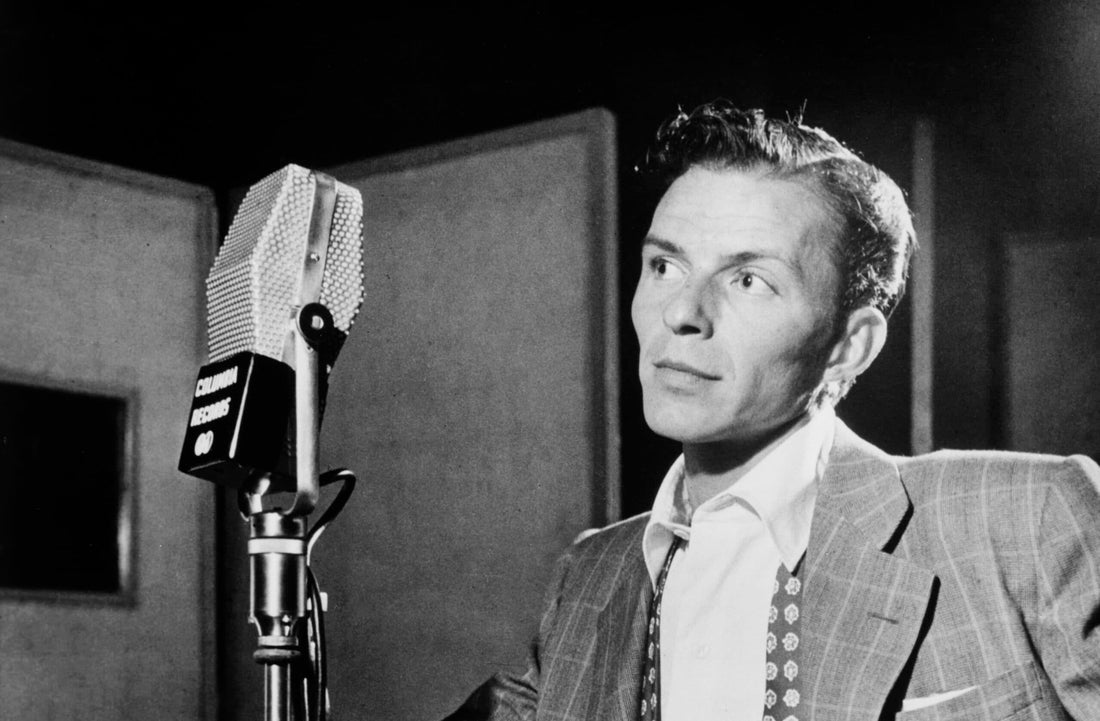In Hoboken, New Jersey, in the year 1915, two Italian immigrants welcomed a baby boy who would grow up to be one of the best-selling and most recognized artists of all time.
Frank Sinatra started out listening to big band singers like Bob Eberle, Bing Crosby, and Gene Austin. Armed with a ukulele, he began singing professionally in high school. His group, the Hoboken Four, won some contests and got airtime on radio and TV. Soon bandleader Harry James noticed the blue-eyed lead singer and hired him.
But Sinatra wasn’t happy with the James band, and switched to the Tommy Dorsey Orchestra after a couple of years. That’s where he really started to make a name for himself. He performed and recorded with Dorsey from 1940-1942, at which point he was longing for a solo career. It took a legal battle (and possibly a Mafia-connected threat) to get out of his contract, but he did so and went on to unprecedented success in the recording studio, concert hall, and movies.
After a long and stellar career, Sinatra died in 1998. There’s no question that he was one of the most important musicians of the 20
th century, and his influence is far from over.
With many of his tracks burned into the cultural consciousness (do you really need me to point you toward his recordings of “My Way” and “New York, New York”?), I tried to find some songs that even a fan might not be so familiar with. I’ve purposely left out his late-career collaborations with pop stars, which is not to say they aren’t important or worth listening to.
There are so many great Sinatra cuts to choose from, I might as well have closed my eyes and picked at random! But I think I found some nice ones. Enjoy these eight tracks by Frank Sinatra.
- Track: “Why Shouldn’t I”
Album: The Voice of Frank Sinatra
Label: Columbia
Year: 1946
Originally issued as a collection of 78s,
The Voice of Frank Sinatra is his debut. The youthful voice is silky and full of nonchalant longing, the perfect crooner’s paradox: Don’t show too much nuanced emotion, but always sound like you’re dreaming of something beyond our daily drudgery.
“Why Shouldn’t I” is a lesser-known Cole Porter number which had enjoyed only a handful of recordings between 1935 and this 1946 track. The sweet orchestral sound comes at the hands of arranger/conductor Axel Stordahl, who had also been with Tommy Dorsey and left at Sinatra’s urging. Here Stordahl is leading a small group that, for at least one of the sessions, included the oboe played by Mitch Miller, a groundbreaking arranger in his own right.
httpv://www.youtube.com/watch?v=65M9IhqQCK4
- Track: “Sunday”
Album: Swing Easy!
Label: Columbia
Year: 1954
You can hear a striking change between “Why Shouldn’t I” and this track eight years on. It’s not just the rich texture of Nelson Riddle’s orchestral arrangements (Riddle would remain one of Sinatra’s favorite collaborators, helping to define his sound). It’s also Sinatra’s singing. His style is more forceful and confident now, and his voice has greater dimension.
The melody of the 1926 song “Sunday” is by Chester Conn, setting lyrics by Jule Styne. It had a resurgence in popularity in the mid-’50s thanks to this Sinatra recording and one the following year by Bing Crosby.
httpv://www.youtube.com/watch?v=kONKxEql_Hs
- Track: “Pocketful of Miracles”
Album: Sinatra’s Sinatra
Label: Reprise
Year: 1963
In 1960, Sinatra left Columbia to start his own record label, Reprise (still in operation, now owned by Warner), through which he created many hit albums. One of those was
Sinatra’s Sinatra, beloved for tracks like “Call Me Irresponsible,” “All the Way,” and “Witchcraft.”
Less well remembered is the charming “Pocketful of Miracles,” a Sammy Cahn and Jimmy Van Heusen tune. This is an example of the numbers Sinatra sometimes did with a children’s chorus (the most famous being “High Hopes”). One of Sinatra’s many gifts was knowing what musicians to surround himself with, and here he’s relying on the great Billy May for arrangements and conducting.
httpv://www.youtube.com/watch?v=LbbtAMzr3dc
- Track: “Wives and Lovers”
Album: It Might As Well Be Swing
Label: Reprise
Year: 1964
While his albums of pop duets in the 1990s might have put Sinatra on the map for a new generation, he did some fantastically fruitful collaborations earlier in his career. On
It Might As Well Be Swing, he shares the limelight with master pianist/composer/bandleader Count Basie. You simply can’t go wrong with this pair-up. In fact, this was their second project together; they made
Sinatra-Basie in 1962.
A young Quincy Jones provided the arrangements. The track list, as you might guess from the album title, comprises songs from non-jazz genres, including Broadway and pop. “Wives and Lovers” is a pop tune by Burt Bacharach and Hal David that had won a Grammy for Jack Jones the previous year. Sinatra clearly felt he had something to add, that something being Count Basie and a whole lotta swing.
httpv://www.youtube.com/watch?v=owujpzDOqjo
- Track: “Oh, You Crazy Moon”
Album: Moonlight Sinatra
Label: Reprise
Year: 1966
First, I tip my hat to whoever came up with this album title. Besides being an excellent pun, the title refers to the theme: Every song has to do with the moon. So there’s “Moonlight Serenade,” “Moonlight Becomes You,” “Reaching for the Moon”-- you get the idea. (Not “Fly Me to the Moon,” however, which was included on the
Might As Well Be Swing Basie album above.)
Jimmy Van Heusen and Johnny Burke wrote “Oh, You Crazy Moon,” and this sax-heavy arrangement is by Nelson Riddle.
httpv://www.youtube.com/watch?v=WvIt7IErIW4
- Track: “Yellow Days”
Album: Francis A. and Edward K.
Label: Reprise
Year: 1968
What a fantastic album this is! Sinatra teamed up with Duke Ellington and His Orchestra for some truly magical music-making. Billy May did the arrangements.
“Yellow Days” was originally written (and often recorded) as a Latin jazz standard, a bolero to be exact, by Álvaro Carillo. Sinatra squares up the rhythm of the vocal part, setting up a great contrast with Ellington’s sultry accompaniment.
httpv://www.youtube.com/watch?v=Hh6Gz_hzg-U
- Track: “Drinking Water (Aqua de beber)”
Album: Sinatra-Jobim
Label: Reprise
Year: 1969
Speaking of Latin jazz, Sinatra had had a big hit with his 1967 collaboration,
Francis Albert Sinatra and Antonio Carlos Jobim (which included their hit version of “Girl from Ipanema”), and they tried to recapture that lightning with this second album. Although sales were poor, a trend that Sinatra had to suffer through for the coming decade, there’s some nice stuff here.
Jobim co-wrote “Drinking Water” with Vinicius de Moraes and Norman Gimbel. It’s interesting to hear Jobim’s bossa-nova scat against Sinatra’s crooning.
httpv://www.youtube.com/watch?v=thS3uO9pnPA
- Track: “The Best of Everything”
Album: L.A. Is My Lady
Label: Qwest/Warner Bros.
Year: 1984
The 1980s saw the resurgence of Sinatra’s career, and he never let up until his passing. This, however, was to be his final solo studio album, although he did those famous duet records almost ten years later.
L.A. Is My Lady features Quincy Jones and His Orchestra, only the second time Sinatra worked with Jones.
“The Best of Everything” was composed by John Kander and Fred Ebb (who also wrote “New York, New York”); as far as I can tell, they wrote it specifically for this record. Sinatra’s voice is craggy from age, and the bright sound of the Jones orchestra is a big change from the deep-toned Ellington or sweet-toned Riddle arrangements of old. But that distinctive Sinatra delivery is the same – there’s no one else it could be.
httpv://www.youtube.com/watch?v=gGLfpoUX7EY
Header image courtesy of Wikimedia Commons/William P. Gottlieb.



